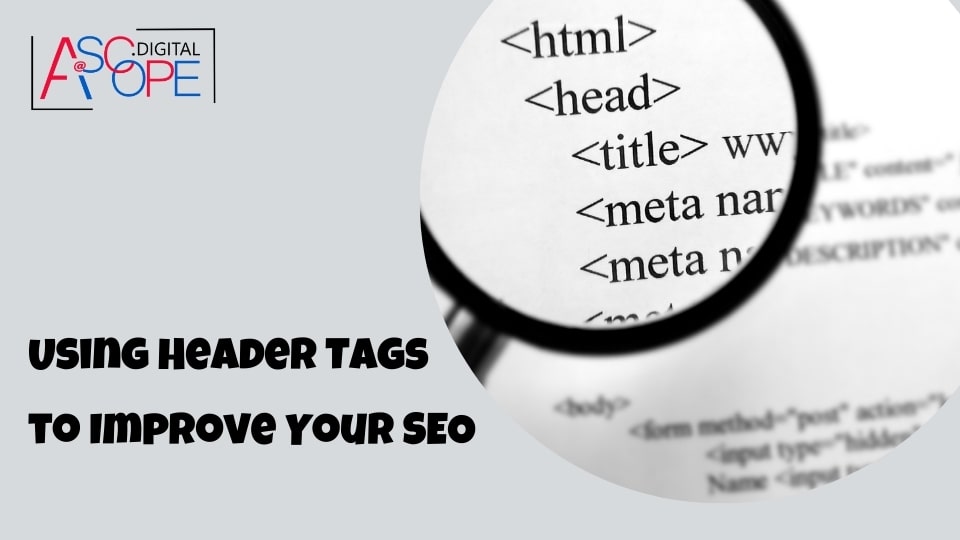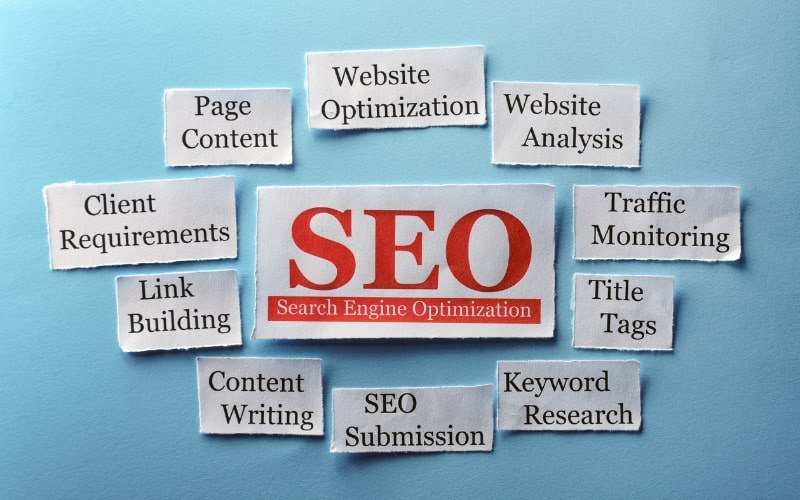Best Practices for Using Header Tags in Your Content

Header tags, or heading tags, are HTML elements (<h1> to <h6>) used to define the headings and subheadings in your content. They help create a clear content structure, improve readability, and enhance SEO. Proper use of header tags can significantly impact how search engines and users perceive your webpage.
Importance of a Single <h1> Tag
Each page should have one <h1> tag to define the main topic. This tag is typically used for the main title of the page, providing a clear indication to both users and search engines about the primary focus of the content. Using multiple <h1> tags can confuse search engines, leading to a diluted understanding of the page’s main topic and potentially harming your SEO efforts.
Incorporate Keywords Naturally
Including relevant keywords in your header tags is crucial for SEO. Keywords help search engines understand the content of your page and its relevance to search queries. However, keyword stuffing—cramming too many keywords into your headers—can make your content awkward and unreadable. Aim for a natural incorporation of keywords that aligns with the flow of your content.
For example, if you’re writing an article about digital marketing strategies, a well-crafted <h2> tag could be “Effective Digital Marketing Strategies for 2024.” This not only includes the keyword but also gives a clear indication of the section’s content.
Maintain a Logical Hierarchy
Header tags should be used in a hierarchical order to create a clear structure. Start with an <h1> tag for the main title, followed by <h2> tags for major sections, <h3> tags for subsections, and so on. Avoid skipping levels (e.g., going from <h1> directly to <h4>), as this can disrupt the logical flow of content and confuse both readers and search engines.
For instance, in an article about SEO techniques, you might use <h2> for sections like “On-Page SEO” and “Off-Page SEO,” <h3> for subsections like “Keyword Research” and “Link Building,” and <h4> for more detailed topics like “Long-Tail Keywords” and “Guest Posting.”
Be Concise and Descriptive
Header tags should be concise yet descriptive enough to give users and search engines a clear idea of the content in each section. Avoid overly long headers that can be overwhelming and difficult to read. Instead, focus on clarity and relevance. For example, instead of a vague <h2> tag like “Details,” use something more specific like “Key Benefits of Using Header Tags.”
Use Header Tags to Break Up Content
Breaking up your content with header tags improves readability by making it easier for users to scan and find the information they need. Long paragraphs can be daunting, but clear headers can act as signposts, guiding readers through your content and helping them locate relevant sections quickly. This is particularly important for mobile users who prefer to skim content.
For example, a blog post on healthy eating habits might use headers like <h2> Benefits of a Balanced Diet</h2>, <h2> How to Plan Your Meals</h2>, and <h2> Healthy Snack Ideas</h2>. These headers break up the content into manageable chunks and make it easier to navigate.
Enhance Accessibility
Proper use of header tags improves the accessibility of your content. Screen readers, used by visually impaired users, rely on header tags to navigate a webpage. Well-structured headings allow these users to understand the layout and jump to specific sections, enhancing their browsing experience. Ensuring that your content is accessible is not only good practice but also aligns with web accessibility guidelines.
Optimize for Featured Snippets
Header tags can help your content appear in featured snippets, the concise answers Google displays at the top of some search results. Structured content with clear headers is more likely to be selected for these snippets. To optimize for featured snippets, use header tags to pose questions (e.g., <h2> What Are the Benefits of SEO?</h2>) and provide concise, informative answers immediately following the headers.
Avoid Using Headers for Styling
Header tags should not be used purely for styling purposes. While it might be tempting to use headers to make text larger or bolder, their primary function is to structure content. Use CSS for styling and reserve header tags for creating a logical hierarchy and improving content organization. Misusing header tags for styling can lead to a disjointed and confusing experience for users and search engines.
Optimizing Header Tags with Target Keywords

Keyword optimization is a fundamental aspect of SEO that involves strategically placing relevant keywords throughout your content to improve its visibility and ranking in search engine results pages (SERPs). One of the most effective places to incorporate these keywords is within your header tags. This practice not only enhances SEO but also improves the overall readability and user experience of your webpage.
Understanding the Role of Keywords in Header Tags
Keywords in header tags signal to search engines the primary topics and subtopics of your content. When search engines crawl your page, they use header tags to understand the structure and relevance of the information provided. Including target keywords in your headers helps search engines categorize your content accurately, increasing the chances of ranking higher for those specific terms.
Choosing the Right Keywords
The first step in optimizing header tags with keywords is selecting the right keywords. Conduct thorough keyword research to identify terms and phrases that your target audience is searching for. Tools like Google Keyword Planner, SEMrush, and Ahrefs can help you find relevant keywords with a good balance of search volume and competition.
For instance, if you are writing about digital marketing strategies, keywords like “digital marketing,” “SEO techniques,” and “content marketing” might be highly relevant. Choose keywords that are specific to the topic of each section and reflect what users are likely to search for.
Incorporating Keywords Naturally
Once you have identified your target keywords, the next step is to incorporate them naturally into your header tags. Avoid forcing keywords into your headers in a way that disrupts the flow of the content. The goal is to enhance readability and provide value to the reader while signaling relevance to search engines.
For example, instead of a forced header like “SEO Techniques Digital Marketing Content,” use a more natural and informative header such as “Top SEO Techniques for Effective Digital Marketing.” This approach ensures that the header is both user-friendly and optimized for search engines.
Using Keywords in Different Header Levels
Distribute your target keywords across different header levels (<h1>, <h2>, <h3>, etc.) to create a well-structured and comprehensive piece of content. The <h1> tag, being the most important, should include the primary keyword that encapsulates the main topic of the page.
For example, if your article is about “Digital Marketing Strategies,” the <h1> could be “Effective Digital Marketing Strategies for 2024.” Subsequent headers (<h2>, <h3>, etc.) can then include secondary and related keywords. For instance, an <h2> might be “Key Components of Digital Marketing,” and an <h3> under that section could be “SEO Techniques for Better Rankings.”
Balancing Keywords with Readability
While keyword optimization is important, maintaining readability and user engagement is crucial. Overloading your header tags with keywords (known as keyword stuffing) can make your content appear spammy and detract from the user experience. Search engines also penalize keyword stuffing, which can negatively impact your rankings.
Aim for a balance where keywords are present but do not overpower the natural flow of the text. Headers should still be concise, informative, and easy to read. This balance helps ensure that your content remains engaging for readers while still being optimized for search engines.
Refreshing and Updating Keywords
SEO is an ongoing process, and keyword trends can change over time. Regularly review and update your keywords to ensure they remain relevant and effective. Tools like Google Trends can help you identify shifts in keyword popularity. Updating your headers with current keywords can help maintain or improve your search engine rankings.
For example, if a new digital marketing trend emerges, you might update your headers to reflect this. An existing <h2> like “Latest Trends in Digital Marketing” could be updated to “Top Digital Marketing Trends for 2024” to capture current search interest.
Monitoring and Measuring Success
After optimizing your header tags with target keywords, it’s important to monitor and measure the success of your efforts. Use SEO tools like Google Analytics and Search Console to track your page’s performance in search rankings. Pay attention to metrics such as organic traffic, bounce rate, and average time on page to assess how well your optimized headers are working.
Analyzing this data can provide insights into what is working and what might need adjustment. For instance, if a particular page is not performing as expected, consider revisiting your keyword strategy and making necessary changes to the headers.
The Role of Header Tags in Featured Snippets and Search Rankings

Featured snippets are concise answers displayed at the top of Google’s search results, aimed at providing users with quick information. They are also known as “position zero” because they appear above the first organic search result. These snippets can significantly increase a webpage’s visibility and drive substantial traffic, making them a valuable SEO target.
How Header Tags Influence Featured Snippets
Header tags play a crucial role in helping content get selected for featured snippets. Google’s algorithm scans web pages for clear and structured information to present in snippets. Properly used header tags make it easier for the algorithm to identify and extract relevant content.
For example, if your page includes a header like <h2>What are the Benefits of SEO?</h2>, followed by a concise and well-structured paragraph answering that question, Google is more likely to feature it in a snippet. The header tag signals to the algorithm that this section contains a specific answer to a common query.
Structuring Content for Snippet Optimization
To optimize your content for featured snippets, structure it in a way that directly addresses common questions and topics relevant to your audience. Use header tags to pose these questions and follow them with clear, concise answers. This approach aligns with Google’s preference for straightforward, easy-to-understand information.
For instance, in an article about digital marketing, you might use headers like <h2>How to Improve Your SEO Rankings?</h2> and <h2>Top Digital Marketing Strategies for 2024</h2>. Under each header, provide detailed yet concise answers that directly address the queries posed by the headers.
Enhancing Search Rankings with Header Tags
Beyond featured snippets, header tags are essential for improving overall search rankings. They help search engines understand the hierarchy and relevance of your content. A well-structured page with clear header tags is more likely to be indexed correctly and ranked higher in search results.
For example, a blog post on healthy eating habits might use <h1> for the main topic, followed by <h2> for major sections like “Nutritional Benefits of Fruits and Vegetables” and “Planning a Balanced Diet,” with <h3> tags for subsections such as “Vitamins and Minerals” and “Daily Meal Plans.” This structure not only enhances readability but also aids search engines in understanding the content’s focus and relevance.
Best Practices for Using Header Tags for SEO
To maximize the impact of header tags on search rankings and featured snippets, follow these best practices:
- Use Headers to Answer Specific Questions: Frame headers as questions that match common search queries. This approach aligns with how users search for information and increases the likelihood of your content being featured.
- Provide Clear and Concise Answers: Directly following the headers, provide answers or information that is easy to read and understand. Use bullet points, lists, and short paragraphs to enhance readability.
- Include Relevant Keywords: Incorporate target keywords naturally within your header tags to signal relevance to search engines. Avoid keyword stuffing, which can negatively impact readability and SEO.
- Maintain a Logical Hierarchy: Use header tags in a logical order (
<h1> for the main topic, <h2> for major sections, and so on) to create a clear structure. This helps search engines and users navigate your content effectively. - Use Headers Consistently: Consistency in header usage across your website ensures a cohesive structure, making it easier for search engines to index your content accurately.
Examples of Effective Header Tag Use
Consider a webpage focused on digital marketing strategies. Here’s how you might structure it for optimal SEO and snippet potential:
<h1>Effective Digital Marketing Strategies for 2024</h1><h2>What is Digital Marketing?</h2>- Answer: A brief explanation of digital marketing.
<h2>Why is SEO Important for Digital Marketing?</h2>- Answer: Key benefits of SEO.
<h2>How to Improve Your Social Media Marketing?</h2>- Answer: Tips and strategies for social media marketing.
<h2>What are the Latest Trends in Content Marketing?</h2>- Answer: Overview of current content marketing trends.
This structure addresses common queries, uses relevant keywords, and provides concise answers, making the content more likely to be featured in snippets and rank well in search results.
Measuring the Impact of Header Tags
To evaluate the effectiveness of your header tag strategy, use tools like Google Analytics and Google Search Console. Monitor metrics such as organic traffic, click-through rates, and the appearance of your content in featured snippets. Adjust your strategy based on these insights to continually improve your SEO performance.
Common Mistakes to Avoid When Using Header Tags

Header tags are essential for organizing content, improving readability, and boosting SEO. However, their effectiveness can be compromised by common mistakes. Understanding and avoiding these pitfalls is crucial to ensuring that header tags contribute positively to your website’s performance and user experience.
Overusing <h1> Tags
One of the most frequent mistakes is overusing <h1> tags. Each page should have only one <h1> tag, which represents the main topic or title of the page. Using multiple <h1> tags can confuse search engines, leading them to misinterpret the structure and focus of your content. This can negatively impact your SEO.
Example: Instead of using multiple <h1> tags for various sections of your page, use a single <h1> for the main title and <h2> or <h3> tags for subheadings.
Skipping Header Levels
Skipping header levels, such as jumping from an <h1> to an <h4> without using <h2> or <h3>, disrupts the logical flow of your content. Search engines rely on a hierarchical structure to understand the relationship between different sections. Skipping levels can make your content harder to parse and less effective for SEO.
Example: Ensure a logical progression by using <h2> for major sections, <h3> for subsections, and so on. This helps maintain a clear content hierarchy.
Using Header Tags for Styling
Another common mistake is using header tags purely for styling purposes. While header tags do make text larger and bolder, their primary purpose is to structure content. Relying on them for visual appeal alone can lead to a disorganized content structure, harming both user experience and SEO.
Example: Use CSS for styling text and reserve header tags for their intended purpose—creating a clear content hierarchy.
Keyword Stuffing in Header Tags
While incorporating keywords in header tags is beneficial, overloading them with keywords (known as keyword stuffing) can be detrimental. Keyword stuffing makes your content appear spammy and can lead to penalties from search engines, reducing your page’s visibility.
Example: Instead of cramming multiple keywords into a header tag, use one or two relevant keywords that naturally fit the context of your content. For instance, “Effective SEO Techniques” is better than “SEO Techniques, SEO Tips, SEO Strategies.”
Using Vague or Non-Descriptive Headers
Headers should be descriptive and provide a clear indication of the content that follows. Using vague or generic headers can confuse readers and fail to convey the importance of the section to search engines.
Example: Replace vague headers like “Introduction” or “Details” with more specific ones like “Introduction to Digital Marketing” or “Key Details on Content Strategy.” This approach helps both users and search engines understand the content better.
Ignoring Header Tag Consistency
Consistency in header tag usage across your website is crucial for maintaining a coherent structure. Inconsistent use of header tags can lead to a fragmented user experience and make it difficult for search engines to index your site accurately.
Example: Develop a standardized approach for using header tags across your site. For example, always use <h2> for main sections and <h3> for subsections to maintain a uniform structure.
Failing to Update and Refresh Headers
Content and keyword trends evolve over time, and failing to update your headers to reflect these changes can make your content less relevant. Regularly revisiting and refreshing your headers ensures that they remain aligned with current SEO best practices and user search behavior.
Example: Periodically review your headers and update them with new keywords or more accurate descriptions to keep your content fresh and relevant.
Advanced Techniques for Leveraging Header Tags in SEO Strategy

Header tags, ranging from <h1> to <h6>, are more than just tools for organizing content; they can be powerful assets in an advanced SEO strategy. Moving beyond basic usage, these advanced techniques can significantly enhance your website’s search engine visibility, user experience, and overall SEO performance.
Semantic Enrichment with Header Tags
Semantic enrichment involves using header tags to provide additional context and meaning to your content. By incorporating semantic keywords—words and phrases that are contextually related to your primary keywords—you can help search engines understand the broader context of your content.
Example: If your primary keyword is “digital marketing,” you might use semantic keywords like “online advertising,” “SEO,” and “content marketing” in your header tags. An <h2> could be “Top SEO Strategies for Digital Marketing,” while an <h3> might be “Content Marketing Tips for Enhanced Online Presence.”
Utilizing LSI (Latent Semantic Indexing) Keywords
LSI keywords are terms that are semantically related to your primary keyword. They help search engines understand the content’s context and improve its relevance. Including LSI keywords in your header tags can boost your SEO by making your content more comprehensive and relevant to a wider range of search queries.
Example: For a blog post about “healthy eating,” LSI keywords might include “balanced diet,” “nutrition,” and “meal planning.” An <h2> could be “Balanced Diet Essentials,” and an <h3> might be “Effective Meal Planning for Nutritional Success.”
Optimizing for Voice Search
Voice search is becoming increasingly popular, and optimizing your header tags for voice queries can enhance your SEO strategy. Voice search queries are typically longer and more conversational than text searches. Structuring your header tags to reflect natural language queries can help capture voice search traffic.
Example: Instead of using a header like “SEO Tips,” use a more conversational header such as “What Are the Best SEO Tips for 2024?” This approach aligns with how users ask questions in voice searches.
Implementing Question-Based Headers
Creating headers in the form of questions can improve your chances of appearing in featured snippets and other prominent search positions. Question-based headers directly address common queries that users type into search engines, making your content more likely to be highlighted.
Example: Use headers like <h2>How to Optimize Your Website for SEO?</h2> or <h2>What Are the Benefits of Content Marketing?</h2>. These headers match common search queries and can increase the likelihood of your content being featured.
Leveraging Long-Tail Keywords
Long-tail keywords are longer and more specific keyword phrases that visitors are more likely to use when they’re closer to making a purchase or finding specific information. Using long-tail keywords in your header tags can attract highly targeted traffic and improve conversion rates.
Example: Instead of a generic header like “Marketing Tips,” use a more specific long-tail keyword such as “Effective Digital Marketing Tips for Small Businesses.” This specificity helps attract users who are looking for detailed, niche information.
Enhancing User Engagement with Interactive Headers
Interactive elements within headers, such as collapsible sections or expandable content, can enhance user engagement. These elements make it easier for users to navigate your content and find the information they need, leading to longer time on site and reduced bounce rates.
Example: Use JavaScript to create collapsible headers that reveal content when clicked. For instance, an <h2> might be “Click to Expand: Advanced SEO Strategies,” which expands to show detailed information when clicked.
Structuring Content for Mobile Users
With the increasing use of mobile devices, optimizing header tags for mobile users is crucial. Ensure that your headers are concise and readable on smaller screens. Mobile-friendly headers improve the user experience and can positively impact your mobile search rankings.
Example: Shorten your headers to make them more mobile-friendly. Instead of a long header like “Comprehensive Guide to SEO for Small Businesses,” use a concise version like “SEO Guide for Small Businesses.”
Monitoring and Analyzing Header Tag Performance
Advanced SEO strategies involve continuous monitoring and analysis. Use tools like Google Analytics and Search Console to track the performance of your header tags. Analyze metrics such as click-through rates, bounce rates, and average time on page to identify which headers are performing well and which need improvement.
Example: Regularly review your analytics data to see which header tags are driving the most traffic and engagement. Use this data to refine your headers and improve your overall SEO strategy.
Conclusion
Leveraging header tags as part of an advanced SEO strategy requires more than just basic implementation. By enriching content semantically, utilizing LSI keywords, optimizing for voice search, implementing question-based headers, leveraging long-tail keywords, enhancing user engagement with interactive headers, structuring content for mobile users, and continuously monitoring performance, you can maximize the effectiveness of your header tags. These advanced techniques not only improve your search engine rankings but also enhance user experience, driving more targeted traffic to your site. Properly used header tags signal relevance and structure to search engines, helping your content stand out in an increasingly competitive digital landscape.
However, header tags are just one piece of the SEO puzzle. If you’re still struggling to drive traffic to your website, there may be other factors at play. Read more on the other reasons why your website isn’t getting traffic to uncover additional insights and strategies for boosting your site’s performance. By addressing all aspects of your SEO strategy, you can ensure your website attracts and retains a steady stream of visitors.








